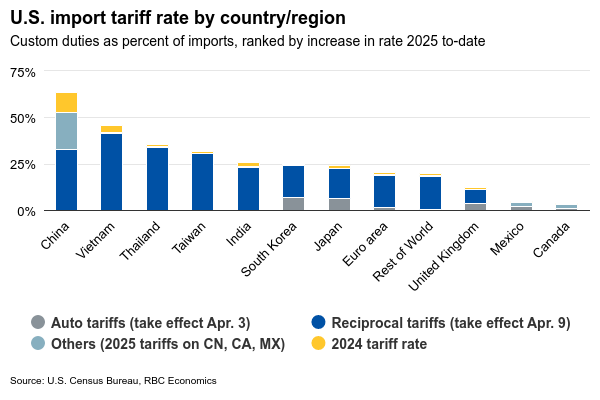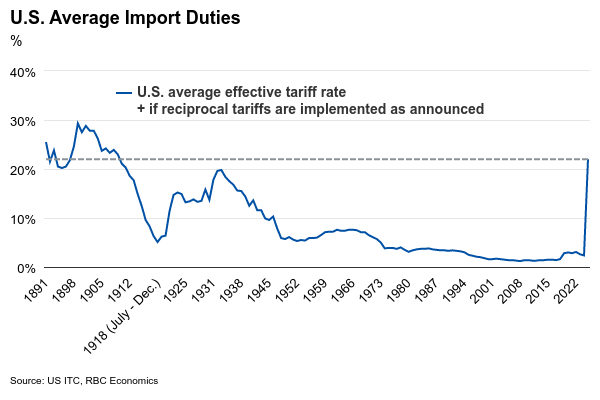U.S. Reciprocal Tariffs Spare Canada/Mexico for Now but Trade Risks Remain
Written by Nathan Janzen and Claire Fan
Published on April 3, 2025
minute read
Share:
This article was originally published by RBC Economics on April 2, 2025 under the title "U.S. reciprocal tariffs spare Canada/Mexico for now but trade risks remain"
The long-awaited U.S. reciprocal tariffs announced have been large and broad-based, but critically exempt Canada and Mexico (at least for now) through CUSMA/USMCA compliant trade.
The announcement includes a baseline 10% minimum tariff rate for all countries as of April 5th, but with substantially higher tariff rates imposed on specific countries to follow on April 9th —particularly those that make up the bulk of the U.S. trade deficit. That includes a 34% increase on import tariffs from China, 26% on India, a whopping 46% on imports from Vietnam, and 20% on imports from the European Union.
Tariffs on imports from Canada are still set to rise on Thursday. Auto tariffs announced last week will still push the average U.S. tariff rate on imports from Canada to about 3.5% from 2.5% by our count That increase will still matter, but looks small now compared to dramatically higher tariffs set to be imposed on other countries.

A lower tariff rate increase is positive for Canada on a relative basis, and it eliminates what had been a growing incentive for U.S. importers to purchase goods from other regions. But that will be little consolation if overall tariffs are large enough to shrink U.S. demand and the total U.S. import market overall.
Prior tariff announcements have been significantly altered or rolled back days (or even hours) after being made, and there is a big possibility that the tariffs announced on April 2 will look different a week from now. But, if the measures from April 2 are implemented, it would push the average U.S. import tariff rate to over 20%— according to our estimates—the highest rate in more than a century.

The April 2 announcement will not be the last on trade from the U.S. administration and we will continue to rely on our tariff playbook1 to assess about how these announcements will impact the Canadian economy.
Magnitude of tariff hikes add downside risks to U.S. growth and supply chains
Broadly speaking, we have argued before that U.S. buyers will have difficulty finding domestically produced alternatives to imports. A wave of retirements and immigration cutbacks limit the amount that American production can increase in the near-term, and capital investments to “reshore” manufacturing production will take years and billions.
Given those constraints in the near-term to U.S. domestic production capacity, the impact of tariffs depends largely on whether alternative, cheaper import markets are available. Canada’s position compared to other countries on import tariffs looked substantially better April 2 than it did the day before. But there’s also the looming threat of whether the total tariffs imposed are large enough to significantly weaken U.S. economic growth and shrink the size of the total import pie.
Furthermore, even though most of Canada’s trade is directly with the U.S., the supply chain disruptions after pandemic lockdowns eased is a reminder of how disruptions globally can spill over to Canadian production and price growth.
The U.S. economy is much less trade sensitive than many of its trading partners (including Canada)—and we do not have a recession as a base case expectation for the U.S. economy. But, tariff hikes, headwinds from government spending cuts, and reduced immigration are adding to yellow flags in the U.S. economic outlook.2
Trade uncertainty is here to stay
With or without additional tariff measures, trade uncertainty is threatening to slow consumer and business spending.
Our tracking of Canadian consumer spending is holding up significantly better than consumer confidence so far. And, motor vehicle sales spiked higher in both Canada and the U.S., likely in part as consumers rushed to get ahead of possible auto tariff hikes.
But, we expect3 business investment in Canada will remain weak regardless of additional tariff measures.
Sources
1. RBC Thought Leadership, "A playbook for how to measure a tariff shock in Canada", January 2025
2. RBC Thought Leadership, "RBC Consumer Spending Tracker", March 2025
3. RBC Thought Leadership, "Trade uncertainty risks extending decades of under-investment in Canada", February 2025
RBC Direct Investing Inc., RBC Global Asset Management Inc. and Royal Bank of Canada are separate corporate entities which are affiliated. RBC Direct Investing Inc. is a wholly owned subsidiary of Royal Bank of Canada and is a Member of the Canadian Investment Regulatory Organization and the Canadian Investor Protection Fund. Royal Bank of Canada and certain of its issuers are related to RBC Direct Investing Inc. RBC Direct Investing Inc. does not provide investment advice or recommendations regarding the purchase or sale of any securities. Investors are responsible for their own investment decisions. RBC Direct Investing is a business name used by RBC Direct Investing Inc. ® / ™ Trademark(s) of Royal Bank of Canada. RBC and Royal Bank are registered trademarks of Royal Bank of Canada. Used under licence. © Royal Bank of Canada 2025.
Any information, opinions or views provided in this document, including hyperlinks to the RBC Direct Investing Inc. website or the websites of its affiliates or third parties, are for your general information only, and are not intended to provide legal, investment, financial, accounting, tax or other professional advice. While information presented is believed to be factual and current, its accuracy is not guaranteed and it should not be regarded as a complete analysis of the subjects discussed. All expressions of opinion reflect the judgment of the author(s) as of the date of publication and are subject to change. No endorsement of any third parties or their advice, opinions, information, products or services is expressly given or implied by RBC Direct Investing Inc. or its affiliates. You should consult with your advisor before taking any action based upon the information contained in this document.
Furthermore, the products, services and securities referred to in this publication are only available in Canada and other jurisdictions where they may be legally offered for sale. Information available on the RBC Direct Investing website is intended for access by residents of Canada only, and should not be accessed from any jurisdiction outside Canada.
Explore More

Three Things We’re Watching This Week
What the Inspired Investor team is watching
minute read

ETF Trends from the RBC Capital Markets Trading Floor
July ETF flows suggest buy-in to current rally and equity markets at all-time-highs
minute read

ETF Trends from the RBC Capital Markets Trading Floor
Here’s what we saw on the trading floor in June 2025
minute read
Inspired Investor brings you personal stories, timely information and expert insights to empower your investment decisions. Visit About Us to find out more.







